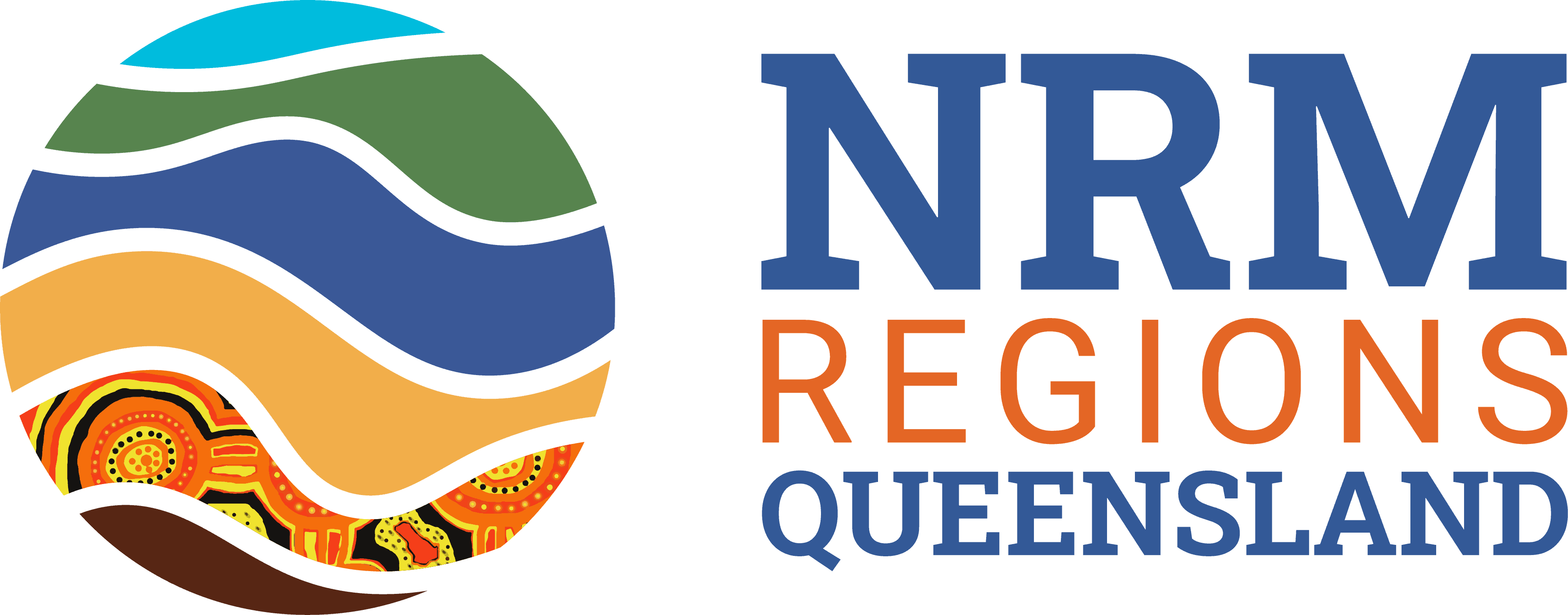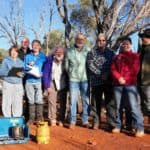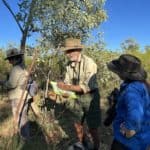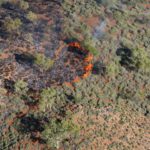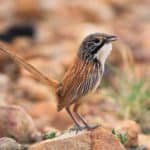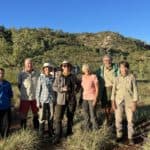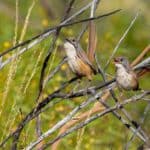The Carpentarian Grasswren (Amytornis dorotheae) is a medium-sized grasswren, endemic to the southern Gulf of Carpentaria. It is a small but striking brown and white bird with a moderately long tail that it flicks erect in a cheeky display.
Historically the species was known from four separate locations across the Northern Territory to Cloncurry in Queensland – an area covering more than 2.8 million hectares:, where targeted surveys have yielded no records for a decade; Wollogorang in the Northern Territory, where only one tiny isolated population remains; Boodjamulla National Park where surveys have recorded species in very low numbers; and Mount Isa which is home to the largest remaining population.
Researchers believe populations in Boodjamulla NP and Mount Isa have been significantly impacted by the availability of habitat following wildfires that have occurred since 2003, particularly in 2011 and 2012.
Wildfire negatively impacts the Carpentarian Grasswren, which is why Southern Gulf NRM is delivering a project, funded by the Australian Government’s National Landcare Program, to reduce the impact of wildfire on this endangered and iconic bird – the focal species of the organisation’s biodiversity conservation program.
The bird is confined to rocky outcrops amoungst mature spinifex grass, and when these areas are burnt, they abandon them unless substantial unburnt pockets remain.
- BirdLife survey volunteers
- Volunteers in the field
- Aerial burn
- Carpentaria Grasswren. Photo: Steve Murphy
- Survey volunteers
- Carpentaria Grasswren male and juvenile. Photo by Anthony Woodbine
The primary threat to Carpentarian Grasswrens is increased wildfire frequency and intensity. This causes changes to the vegetation communities in their spinifex habitats.
Individuals are known to occupy stable breeding territories of an estimated 1.5km2 in size. While Carpentarian Grasswrens are likely to disperse and establish new territories through relatively intact landscapes, their ability to disperse across burnt landscapes is limited.
Inappropriate fire regimes are currently threatening the remaining populations as the extent of controlled burning over the species range has declined, resulting in the accumulation of high fuel loads over large expanses.
The spread of introduced pasture grasses such as buffel grass is also thought to contribute to more frequent fires which spread across a greater extent of the landscape and burn deeper into rocky refuges. Feral cats are also a threat to the species.
While there is no formal Recovery Plan for the Carpentarian Grasswren, the Conservation Advice does list recommended conservation actions for the species’ recovery. Top of the list is fire management. And that is the focus of Southern Gulf NRM’s biodiversity project.
The project aims to stabilise the trajectory of the species as well as increase awareness and adoption of land management practices that improve the condition of vegetation and biodiversity impacting the bird.
Project Officer Lyndy Skea said the organisation and its partners simply wanted to reduce the threat of wildfires to the bird.
“We want to secure the Carpentarian Grasswren’s future by promoting the persistence of old-growth spinifex needed for the species’ survival,” she said.
Working in collaboration with researchers, Birdlife Australia, Mount Isa Rural Fire Service, fire ecology consultants, pastoralists, government agencies, mining companies, philanthropists, and local corporations, Southern Gulf NRM has:
- Built the capacity of pastoralists and land managers by running annual fire training workshops so people can carry out best practice fire management for the bird’s habitat.
- Implemented a burn program that plans for priority burns using aerial incendiaries with a fire consultant while also mapping fire scars.
- Monitored fire scars for biodiversity condition using the Queensland Government’s BioCAT assessment tool.
- Coordinated surveys in partnership with Birdlife North Queensland as well as volunteers on Calton Hills and Thorntonia Stations.
- Supported research by PhD student Henry Stoetzel (UQ), who has been involved in the project since 2019 and is researching habitat modelling, breeding biology, foraging behaviour, genetics and social organisation while also undertaking acoustic monitoring.
- Supported the Development of an acoustic recogniser by BirdLife North Queensland and Henry Stoetzel, to improve the efficiency of detecting the presence of Carpentarian Grasswren vocalisations in acoustic data from the use of Acoustic Recorder Units as a monitoring tool in the field.
- Extended the focus by securing funding to expand the project to include more areas within the Carpentaria Grasswren Corridor.
To date, some 48,988ha of prescribed burning has taken place, and more than 8,800 volunteer hours have been contributed to surveying the bird.
“We want to avoid large wildfires like those that spread across North West Queensland in 2011 and 2012,” Lyndy said. “as they can have devasting effects on biodiversity and land condition.”
Kath Shurclifff from BirdLife North Queensland said the organisation had been conducting surveys for Carpentarian Grasswrens since 2008.
“The Carpentarian Grasswren has almost disappeared from its former range in the Northern Territory due to extensive and prevalent wildfires burning out its habitat,” she said.
“We became concerned that this same decline might happen with our grasswrens in Queensland if we did not take active measures to protect them from wildfires.”
“Fortunately we were able to join with Southern Gulf NRM who also wanted to protect these important regional landscapes.”
“They have worked with local station owners and land managers to develop a regional fire management strategy and secure funds to make this happen on the ground. This partnership can ensure that these management actions will substantially benefit our unique grasswren species,” Kath said.
View Phase One project report: Fire Management for the Carpentarian Grasswren here.
This project is delivered by Southern Gulf NRM, through funding from the Australian Government’s National Landcare Program.
Feature image by Steve Murphy.
